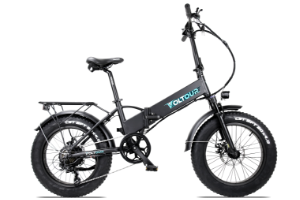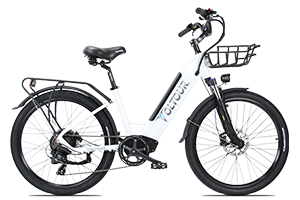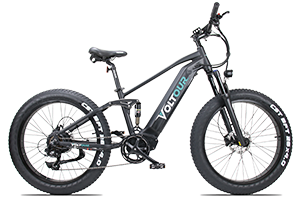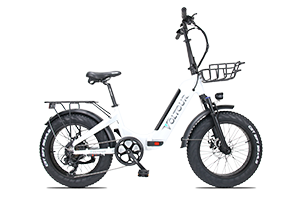What are eBikes?
E-bikes are bikes that are equipped with an electric motor and battery that gives you a little boost of power needed to trek through different terrains.
How does eBike work?
An ebike is a bike that is equipped with a motor and battery that give you two modes: pedal assist and throttle. The rider can pedal freely or use the pedal assist mode to help put some power behind pedaling. Throttle mode provides power to increase speed quickly or to keep the bike moving if the rider wants to take a break from pedaling.
What is Pedal Assist?
All ebikes offer pedal-assist mode to riders, which separates them from regular bicycles. Pedal-assist mode provides power from the motor to help the rider move faster and pedal easier. Voltour e-bikes come with five levels of pedal assistance. The pedal-assist levels determine the amount of power the rider relies on versus pedaling.
How to repair a broken part?
Please contact Voltour Customer support for assistance.
Where can you buy replacement parts?
Yes, replacement parts are available on the website.
Are stolen bikes covered under warranty?
Stolen bikes are not our responsibility and not covered under warranty. We recommend the rider take every precaution to prevent theft, such as purchasing and using a bike lock and storing a safe location.
What is the rating/wattage of the battery or motor?
Please see chart below for information on the models.
| Model |
Battery |
Motor |
| Patriot |
11.6AH Lithium Battery |
48V 750W Bafang Motor
|
|
Dash
|
11.6AH Lithium Battery |
48V 750W Bafang Motor |
|
Jet
|
11.6AH Lithium Battery |
48V 350W Bafang Motor
|
|
Jet 2.0
|
11.6AH Lithium Battery |
48V 500W Sanda Motor |
|
Ranger
|
14.5AH Lithium Battery |
48V 750W Bafang Motor |
Where can you ride an eBike to?
Anywhere! Depending on the type of tires your eBike has, you will have to take extra caution on different terrains.
How do you know which eBike is suitable for which occasion?
There are various aspects of an eBike that will need to consider when buying an eBike, we recommend taking our eBike quiz to find the best pick for you.
What's the difference between road vs mountain eBikes?
Our mountain bike (Ranger) model is equipped with a full suspension and all terrain tires while our road bike models (Jet) is equipped with a single suspension and city tires.
How do you properly store the eBike?
We recommend storing your eBike in a safe, dry and cool place to prevent from theft, rust, corrosion and damages to the battery. Do not store the eBike in extreme temperatures.
Are eBikes difficult to ride?
If you can ride a regular bike, riding an eBike will not be difficult. We do recommend first time eBike riders to test out the bike in an open space to get acquainted with the difference in speed and power.
Are eBikes safe to ride in the rainy or icy conditions?
Comparable to a regular bicycle, you can ride an e-bike in the rainy or icy conditions. However, we recommend taking extra precautions when operating the bike in wet, snowy, or icy conditions, such as:
- decreasing your speed
- avoiding riding on slippery surfaces wearing reflective clothing
- using approved safety lights
- braking earlier than needed as it will take longer to slow down than in dry conditions
We will do our best to warn you of every danger and advise you on every precaution you should take. However, it is not practical or possible to warn you of all hazards associated with operating your eBike, so you must use good judgment. After riding in wet conditions, we recommend drying off your bike and storing it in dry conditions between uses to prevent rust and corrosion.
How do you charge an eBike?
Use the battery charger that is included and insert the charging cable connection into the charging terminal that is located on the bike's frame. For more information, please see the "Charging the Battery" section of your user manual.
How long does eBikes take to charge?
The charging time will vary depending on how much the battery is discharged, however, we estimate that it will take 6 hours to charge a completely discharged battery.
Can you leave eBikes outside?
We do not recommend leaving bikes outside for an extended period due to weather conditions that may affect the operation of your ebike. If you need to leave your bike outside for a short time, we do recommend locking your bike to prevent theft.
Why are there class stickers on my eBike?
Every state that recognizes electric bikes identify them in 3 classes:
Class 1: eBikes that are pedal assist only, with no throttle, and have a maximum assisted speed of 20 mph.
Class 2: eBikes that also have a maximum speed of 20 mph but are throttle-assisted.
Class 3: eBikes that are pedal assist only, with no throttle, and a maximum assisted speed of 28 mph.
The eBikes are required by law to be labeled with one of the above stickers. We do not recommend the removal of this sticker. If you must remove it due to damages or fading, please be sure to relabel the bike with the correct class sticker.
Voltour eBikes are set as Class 2 eBikes by default.
How old do you have to be to ride an eBike?
The minimum age recommended to ride an eBike is 18 or older. A person younger than 18 may lack the necessary judgment and skill to safely operate the eBike. Some local regulations may require riders to be a certain age and qualifications, we recommend looking into your local laws and regulations before operating your eBike.
What is Pedal Assist?
All e-bikes offer pedal-assist mode to riders, which separates them from regular bicycles. Pedal-assist mode provides power from the motor to help the rider move faster and pedal easier. Voltour e-bikes come with five levels of pedal assistance. The pedal-assist levels determine the amount of power the rider relies on versus pedaling. Below are the pedal assist levels for Voltour eBikes:
| Pedal Assist Level |
Speed |
| PAS0 |
0 |
| PAS1 |
8 |
| PAS2 |
12 |
| PAS3 |
14 |
| PAS4 |
17 |
| PAS5 |
20 |
How much electricity does it take to charge a battery?
It usually takes about 500–800-watt hours (0.4 - 0.8 kilowatt hours) to charge, depending on the battery's capacity. In this instance, a rate of $0.10/kWh will cost at least 5-8 cents to charge a battery that will last 20-80+ miles.







